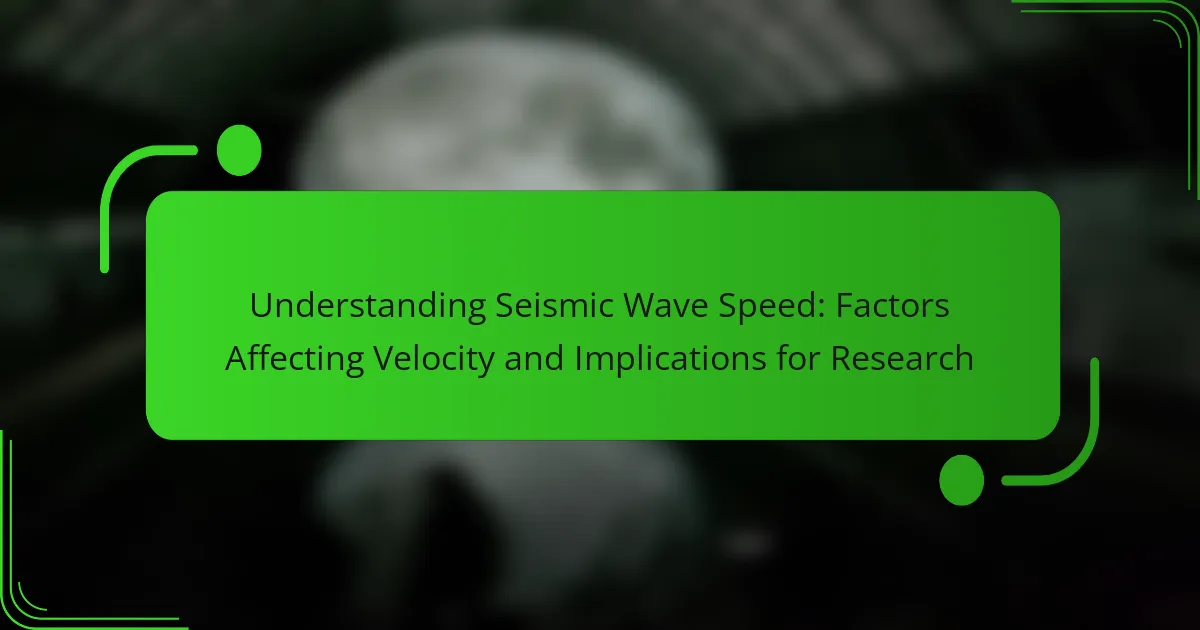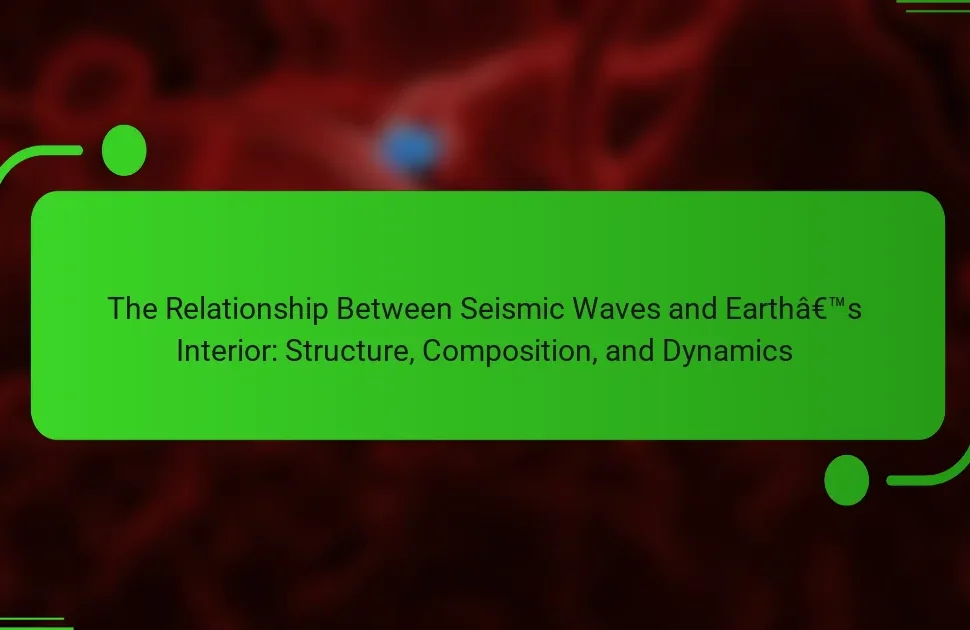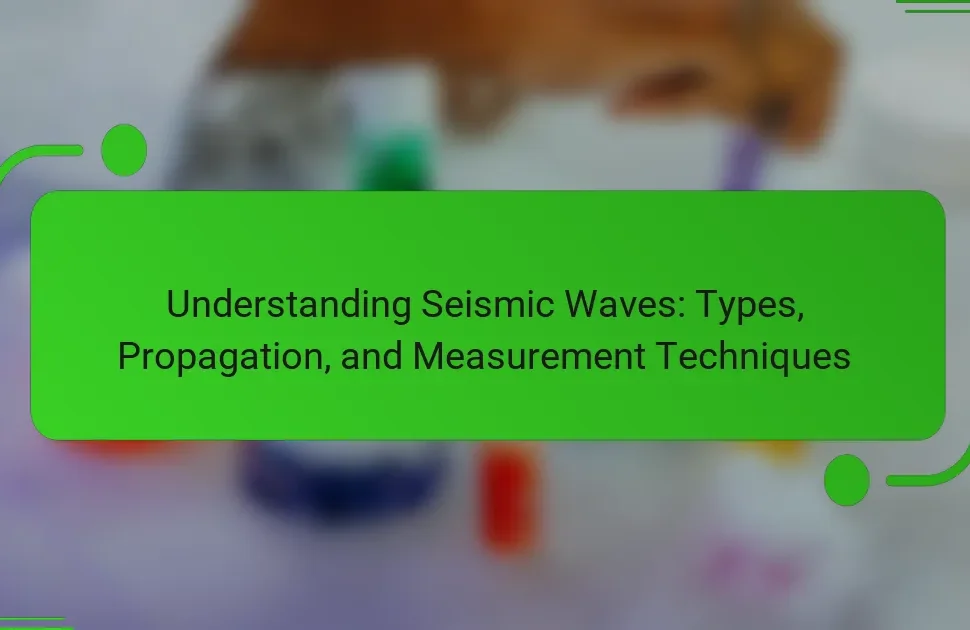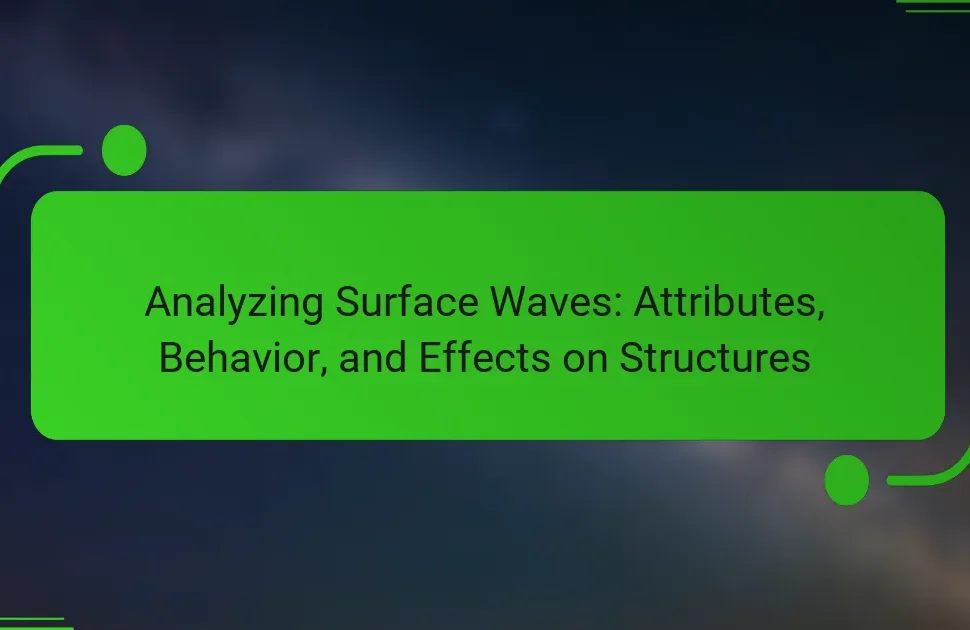Seismic wave speed is the velocity at which seismic waves travel through various geological materials, influenced by factors such as wave type, material density, elasticity, and temperature. Primary waves (P-waves) typically travel faster than secondary waves (S-waves), with P-waves reaching speeds of 5 to 8 kilometers per second in the Earth’s crust, while S-waves travel at 60 to 70 percent of that speed. Understanding seismic wave speed is essential for interpreting seismic data, assessing geological structures, and improving earthquake engineering and risk assessment. This research has broader implications, aiding in resource exploration and contributing to models of tectonic plate movements and climate change studies.

What is Seismic Wave Speed?
Seismic wave speed refers to the velocity at which seismic waves travel through the Earth’s materials. This speed varies based on the type of wave, the material it travels through, and the conditions present. Primary waves, or P-waves, typically travel faster than secondary waves, or S-waves. For example, P-waves can reach speeds of approximately 5 to 8 kilometers per second in the Earth’s crust. In contrast, S-waves generally travel at about 60 to 70 percent of the speed of P-waves. The speed of seismic waves is influenced by factors such as density, elasticity, and temperature of the material. Understanding seismic wave speed is crucial for interpreting seismic data and assessing geological structures. It also plays a significant role in earthquake engineering and risk assessment.
How is Seismic Wave Speed Measured?
Seismic wave speed is measured using various methods, primarily through the analysis of seismic data collected during earthquakes or controlled sources. Instruments such as seismographs record the arrival times of seismic waves at different locations. By calculating the time difference between the arrival of primary (P) waves and secondary (S) waves, researchers can determine wave speeds.
Additionally, seismic refraction and reflection techniques are used to measure wave speed in subsurface materials. These methods involve sending seismic waves into the ground and analyzing how they are reflected or refracted by different geological layers. The velocity can also be calculated using the equation: wave speed equals distance divided by time.
Studies have shown that seismic wave speeds vary depending on the material properties of the Earth’s layers. For instance, P-wave speeds in granite can reach approximately 5 to 6 km/s, while S-wave speeds are typically lower. This variability is crucial for understanding geological structures and assessing earthquake impacts.
What instruments are used to measure Seismic Wave Speed?
Seismic wave speed is measured using instruments such as seismometers and accelerometers. Seismometers detect ground motion caused by seismic waves. They provide data on the speed and amplitude of these waves. Accelerometers measure the acceleration of ground motion. Both instruments can be used in various configurations to capture seismic data. Their readings help in calculating wave speed through different geological materials. Seismic surveys often utilize arrays of these instruments for comprehensive data collection.
How do different environments affect measurement accuracy?
Different environments significantly affect measurement accuracy in seismic studies. Variations in temperature, pressure, and material properties influence seismic wave speed. For instance, higher temperatures generally lead to increased wave speeds due to reduced density. Conversely, increased pressure can enhance wave velocity in fluids. The presence of geological structures, such as faults or varying rock types, can also disrupt wave propagation. These disruptions can lead to scattering and attenuation of seismic signals. Research shows that measurement errors can exceed 10% in heterogeneous environments. Accurate models must account for these environmental factors to improve seismic data reliability.
Why is Understanding Seismic Wave Speed Important?
Understanding seismic wave speed is important because it provides insights into Earth’s internal structure. Seismic waves travel at different speeds through various materials. This speed variation helps geologists identify rock types and their properties. Accurate seismic wave speed measurements can predict earthquake behavior. They also assist in oil and gas exploration by indicating reservoir locations. Additionally, understanding these speeds aids in assessing seismic hazards. Studies show that seismic wave speed correlates with material density and elasticity. Thus, knowing wave speeds enhances our understanding of geophysical processes.
How does Seismic Wave Speed contribute to earthquake research?
Seismic wave speed is crucial in earthquake research as it helps scientists understand the Earth’s internal structure. Different types of seismic waves travel at varying speeds through different materials. By analyzing these speeds, researchers can infer the composition and state of geological layers. For instance, seismic waves travel faster through solid rock than through liquid. This speed variation allows for the identification of boundaries between different materials, such as the crust and mantle. Studies, like those conducted by the United States Geological Survey, demonstrate that seismic wave speed data can predict earthquake locations and magnitudes. Accurate measurements of wave speed enhance models that simulate earthquake behavior. Thus, seismic wave speed is a fundamental tool in assessing seismic hazards and improving safety measures.
What role does Seismic Wave Speed play in geological studies?
Seismic wave speed is crucial in geological studies as it helps determine the Earth’s internal structure. By analyzing the speed of seismic waves, geologists can infer the composition and properties of various geological layers. Different materials, such as rocks and fluids, affect wave speed differently. For instance, seismic waves travel faster in denser materials. This relationship allows researchers to identify boundaries between layers, such as the crust and mantle. Additionally, seismic wave speed aids in locating earthquake epicenters. Accurate measurements of wave speed enhance our understanding of tectonic processes and earthquake mechanics. Thus, seismic wave speed plays a vital role in interpreting geological data.

What Factors Affect Seismic Wave Speed?
Seismic wave speed is primarily affected by the material properties of the medium through which the waves travel. Factors include density, elasticity, and temperature of the geological materials. Higher density typically results in slower wave speeds, while increased elasticity allows for faster wave propagation. Temperature variations can also influence wave speed, as warmer materials tend to reduce density and increase speed. Additionally, the presence of fluids within the rocks can decrease seismic wave speed due to lower effective stress. Research has shown that in solid materials, seismic waves travel faster than in liquids or gases. For example, seismic waves travel at approximately 5 to 7 km/s in granite, whereas in water, they travel at about 1.5 km/s. These factors collectively determine how quickly seismic waves propagate through the Earth’s layers.
How do Material Properties Influence Seismic Wave Speed?
Material properties significantly influence seismic wave speed. Seismic wave speed varies based on the density and elasticity of the material. Denser materials typically transmit seismic waves faster due to their ability to store and transmit energy more efficiently. Elasticity, measured by the modulus of elasticity, affects how quickly waves can propagate through a medium. Higher elasticity allows for faster wave speed as the material can return to its original shape more quickly after deformation.
For example, seismic waves travel faster in granite, a dense and elastic rock, than in clay, which is less dense and less elastic. Laboratory experiments and field studies confirm these relationships, demonstrating that seismic wave speed correlates with material properties. Understanding these influences is crucial for accurately interpreting seismic data and assessing geological structures.
What are the effects of density and elasticity on wave speed?
Wave speed is affected by both density and elasticity of the medium. Higher density typically results in slower wave speed. This occurs because denser materials require more energy to move the particles. Conversely, greater elasticity leads to faster wave speed. Elastic materials can return to their original shape quickly after deformation, facilitating quicker wave propagation. The relationship between wave speed, density, and elasticity is described by the formula: wave speed = √(elasticity/density). This formula shows that as elasticity increases or density decreases, wave speed increases.
How does temperature impact Seismic Wave Speed in different materials?
Temperature affects seismic wave speed by altering the physical properties of materials. As temperature increases, materials often expand, which can reduce their density. Lower density generally leads to decreased seismic wave speeds. For example, in rocks, higher temperatures can cause changes in mineral structures, impacting wave propagation.
In fluids, such as water, increased temperature reduces viscosity, allowing seismic waves to travel faster. Research indicates that in granite, seismic wave speed decreases by about 0.1% for every degree Celsius increase in temperature.
Conversely, in some materials, increased temperature may enhance wave speed due to changes in elasticity. Therefore, the relationship between temperature and seismic wave speed is complex and varies across different materials.
What Environmental Factors Impact Seismic Wave Speed?
Seismic wave speed is influenced by several environmental factors. Key factors include temperature, pressure, and material composition of the Earth’s layers.
Higher temperatures generally reduce wave speed due to decreased material rigidity. Increased pressure, conversely, tends to increase wave speed by enhancing material density.
The composition of geological materials also plays a crucial role. For instance, seismic waves travel faster through solid rock compared to softer sediments.
Water saturation in sediments can further affect wave speed. Saturated materials often exhibit slower wave propagation compared to dry counterparts.
These relationships are well-documented in geophysical studies, confirming that environmental conditions significantly impact seismic wave behavior.
How does the type of geological formation affect wave speed?
The type of geological formation significantly affects wave speed. Different materials have varying densities and elastic properties. For example, seismic waves travel faster in solid rock than in unconsolidated sediments. The wave speed in granite can reach approximately 5,500 meters per second. In contrast, wave speed in loose sand may be around 200 to 400 meters per second. This variation occurs because denser and more rigid materials transmit energy more efficiently. Additionally, the presence of fluids in geological formations can further reduce wave speed. Thus, understanding these factors is crucial for accurate seismic analysis and interpretation.
What role does water saturation play in altering wave speed?
Water saturation significantly affects wave speed in geological materials. Increased water saturation typically leads to a decrease in wave speed. This occurs because water-filled pores reduce the overall stiffness of the material. Consequently, wave propagation is slower in saturated conditions compared to dry conditions.
Research indicates that for saturated soils, P-wave velocities can be significantly lower than in unsaturated states. For example, studies show that the presence of water can reduce shear wave velocities by up to 50%. This relationship is crucial for understanding seismic responses in various environments.
In summary, higher water saturation generally results in slower wave speeds due to decreased material stiffness.

What are the Implications of Seismic Wave Speed Research?
Seismic wave speed research has significant implications for understanding Earth’s internal structure. It aids in identifying the composition and state of geological materials. Accurate measurements of wave speed help in assessing earthquake risks. They also contribute to improved models of tectonic plate movements. Enhanced seismic models can lead to better disaster preparedness. Additionally, this research supports resource exploration, such as oil and gas. Understanding wave speed can also inform climate change studies by revealing subsurface processes. Thus, seismic wave speed research is crucial for various scientific and practical applications.
How does Seismic Wave Speed Research Inform Construction Practices?
Seismic wave speed research informs construction practices by providing critical data on soil and rock properties. This data helps engineers assess ground stability and seismic risk. Accurate seismic wave speed measurements allow for better foundation design. For instance, faster wave speeds typically indicate denser materials, which can support heavier structures. Conversely, slower wave speeds may signal weaker soils that require special consideration. Research findings guide the selection of appropriate construction materials and techniques. A study by McGarr et al. (2015) demonstrates how seismic wave speed correlates with soil liquefaction potential, emphasizing its importance in earthquake-prone areas. Understanding these relationships ultimately enhances the safety and resilience of built environments.
What guidelines can builders follow based on wave speed data?
Builders should use wave speed data to assess soil stability and foundation design. Wave speed indicates the stiffness of soil and rock layers. Higher wave speeds suggest denser and more stable materials. Builders can utilize this data to determine appropriate foundation types. For example, shallow foundations are suitable for high wave speed areas. In contrast, deep foundations may be necessary in low wave speed zones. Additionally, wave speed data helps predict potential seismic activity impacts. Builders can incorporate seismic design measures based on localized wave speed assessments. This approach minimizes structural risks during earthquakes.
How can understanding wave speed improve safety in construction?
Understanding wave speed can significantly improve safety in construction by facilitating better assessment of soil and structural integrity. Accurate knowledge of wave speed helps engineers evaluate how seismic waves travel through different materials. This evaluation is essential for predicting how structures will respond to earthquakes. For example, faster wave speeds typically indicate denser, more stable materials. Conversely, slower wave speeds may signal weaker or more problematic soil conditions. The National Earthquake Hazards Reduction Program states that understanding these dynamics can lead to safer building designs. Additionally, it aids in identifying areas most at risk during seismic events. By integrating wave speed data into construction planning, safety measures can be enhanced effectively.
What Future Research Directions are Emerging in Seismic Wave Speed Studies?
Future research directions in seismic wave speed studies include the integration of machine learning techniques. These techniques can enhance the accuracy of seismic velocity models. Additionally, researchers are focusing on the effects of anisotropy in wave propagation. Understanding how different geological formations influence wave speed is crucial. Another direction is the exploration of real-time monitoring systems. These systems can provide immediate data on seismic activity. The use of advanced computational methods is also gaining attention. These methods can simulate complex seismic scenarios more efficiently. Collaboration across disciplines is essential for these advancements. Interdisciplinary approaches will likely yield new insights into seismic wave behavior.
How might advances in technology enhance our understanding of wave speed?
Advances in technology can enhance our understanding of wave speed through improved measurement techniques. High-resolution sensors enable precise detection of seismic waves. This accuracy leads to better data on wave propagation. Enhanced computational models allow for complex simulations of wave behavior. These models can incorporate various geological conditions. Real-time data processing improves the speed of analysis. Advanced imaging technologies reveal subsurface structures affecting wave speed. Collectively, these advancements contribute to a more comprehensive understanding of seismic wave dynamics.
What new methodologies are being explored in seismic research?
Recent methodologies in seismic research include machine learning techniques for data analysis. These methods enhance the interpretation of seismic data and improve accuracy. Researchers are also exploring the use of distributed acoustic sensing (DAS) for real-time monitoring. DAS utilizes fiber optics to capture seismic waves over large areas. Another methodology involves the integration of multi-scale modeling approaches. This helps in understanding complex geological structures and wave propagation. Advanced inversion techniques are being developed to refine subsurface imaging. These techniques allow for better resolution of geological features. Additionally, the use of citizen science is gaining traction to collect seismic data from diverse locations. This participatory approach broadens the data pool for analysis.
What Practical Tips Can Enhance Understanding of Seismic Wave Speed?
To enhance understanding of seismic wave speed, engage with practical simulations and visualizations. Utilize software tools that model seismic waves in various geological settings. Study the relationship between wave speed and material properties, such as density and elasticity. Conduct hands-on experiments with different materials to observe speed variations. Analyze real-world seismic data to connect theory with practice. Participate in workshops or online courses focused on seismic wave analysis. Collaborate with experts in geophysics for deeper insights. Review case studies of past seismic events to contextualize wave behavior.
Seismic wave speed is the velocity at which seismic waves propagate through various Earth materials, influenced by factors such as wave type, material properties, and environmental conditions. This article examines how seismic wave speed is measured, the instruments used, and the implications of understanding these speeds for geological studies, earthquake research, and construction practices. Key topics include the relationship between wave speed and material density, elasticity, temperature, and the impact of geological formations on wave propagation. Additionally, it discusses emerging research directions and methodologies that enhance our understanding of seismic wave behavior. Understanding these aspects is crucial for assessing seismic hazards and improving safety measures in engineering and resource exploration.




